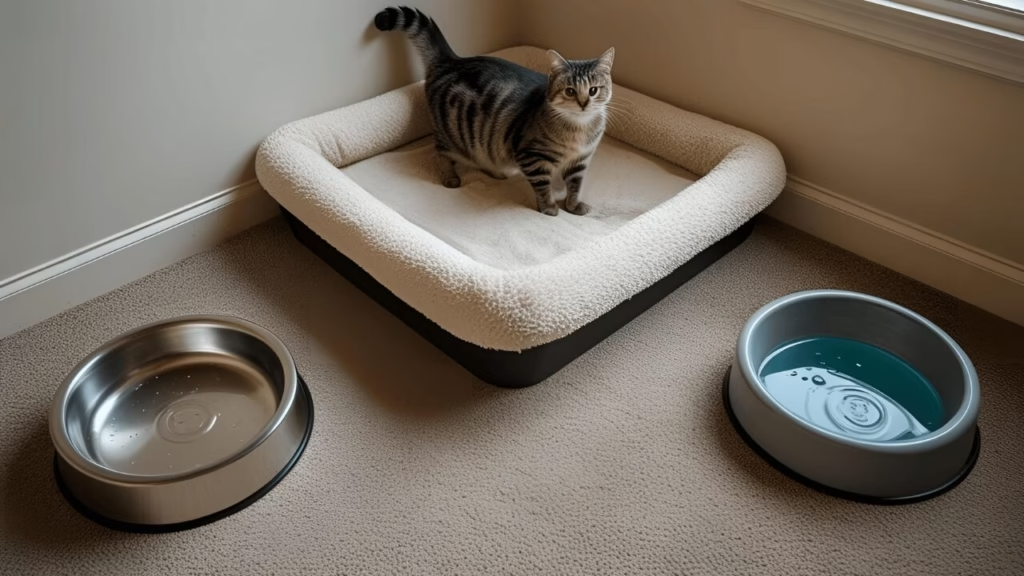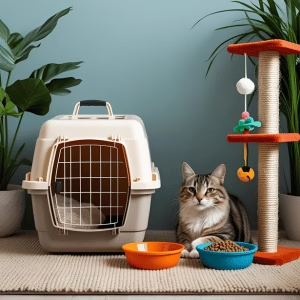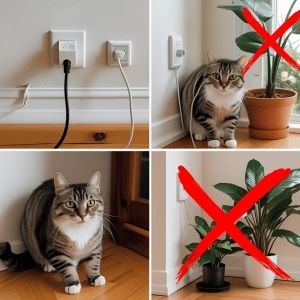So, you’ve decided to adopt a rescue cat, congratulations!
But here’s the thing.
Bringing home a furry friend isn’t just about picking them up and hoping for the best. There’s prep work involved, and trust me, your new kitty will thank you for it.
Think about it this way: imagine moving to a completely new place where everything smells different, sounds different, and looks different. Pretty overwhelming, right?
That’s exactly what your rescue cat is going through.
The good news? With some thoughtful preparation, you can make this transition smooth as silk for both of you.
If you’re looking for tips on adopting a cat, I suggest checking out our Complete Shelter Cat Adoption Guide, which contains everything you need to know before and after adopting a cat.
Understanding What Makes Rescue Cats Special
Here’s what most people don’t realize about rescue cats.
They’re not just regular cats who happened to end up in shelters. Many come with baggage, and I don’t mean the cute kind.
We’re talking about cats who might have experienced trauma, neglect, or simply the stress of being bounced around from place to place.
Some arrive skittish and hide under beds for weeks. Others might be overly clingy, following you everywhere like a furry shadow. And then there are those who seem perfectly fine but suddenly develop behavioral quirks weeks later.
The point is, rescue cats need extra patience and understanding.
But here’s the beautiful part, once they settle in and trust you? The bond you’ll form is absolutely incredible.
Your Pre-Arrival Shopping List (The Essentials Only)
Alright, let’s talk supplies.
Walk into any pet store, and you’ll be bombarded with a million gadgets and gizmos that supposedly every cat “needs.”
Spoiler alert: they don’t.
Here’s what actually matters:
Food and Water Setup
Get yourself some sturdy bowls, ceramic or stainless steel work best. Plastic can harbor bacteria and some cats develop chin acne from it. Weird but true.
You’ll want separate bowls for wet food, dry food, and water. And here’s a pro tip: cats prefer their water away from their food. Something about not wanting to drink where they eat, they’re picky like that.
The Litter Box Situation
One large box with low sides is your starting point. Skip the fancy covered ones for now, many cats feel trapped in them, especially anxious rescue cats.
As for litter, go unscented and clumping. Your nose might prefer lavender-scented litter, but your cat’s sensitive nose definitely doesn’t.
Comfort Items
A cozy bed, a scratching post (trust me on this one, your furniture will thank you), and a sturdy carrier for vet visits.
That’s it. Really.
You can always add more later once you figure out your cat’s personality and preferences.
Creating the Perfect Safe Room (This Is Crucial)
Now, here’s where things get interesting.
Most new cat parents want to give their rescue the full house tour immediately. “Look, Whiskers! Here’s the living room, here’s the kitchen, here’s where we keep the good snacks!”
Stop right there.
Your rescue cat needs a safe room, a single space where they can decompress and feel secure. Think of it as their home base, their fortress of solitude.
Choosing the Right Space
A spare bedroom works perfectly, but even a large bathroom can do the trick. The key is having a door that closes and enough space for all their essentials.
Setting It Up Smart
Here’s the layout that works: litter box in one corner (as far from food as possible), food and water in another area, bed and hiding spots away from the door, and maybe a window for some entertainment.
Cats are naturally clean creatures, so they appreciate having their dining room separate from their bathroom. Makes sense when you think about it.
Cat-Proofing: Because Curiosity Really Can Hurt the Cat
Let’s be real here.
Cats are basically furry toddlers with better climbing skills and sharper claws. They’ll investigate everything, taste things they shouldn’t, and somehow find danger in the most innocent-looking objects.
The Obvious Hazards
Toxic plants (lilies are especially deadly), cleaning products, medications, and foods like chocolate and garlic. These should be locked away or completely removed.
The Not-So-Obvious Ones
Hair ties, rubber bands, string, and small objects that look fun to bat around but can cause intestinal blockages if swallowed.
Electrical cords are like cat magnets, they love to chew on them. Cord protectors are your friend here.
And those blind cords with dangling strings? Either cut them short or replace the blinds entirely. I’ve seen too many close calls with those.
Feeding Your Rescue Cat (It’s Not Just About the Food)
Here’s something that might surprise you.
The food you choose matters, but how and when you feed your cat matters just as much.
Nutrition Basics
Cats are obligate carnivores, fancy way of saying they need meat to survive. Look for foods with real meat as the first ingredient and that AAFCO seal of approval.
But here’s the kicker: don’t switch foods immediately. Ask the shelter what your cat has been eating and stick with it for at least the first week. Their digestive system is already stressed from the move, no need to add food changes to the mix.
Creating Positive Associations
Feed your cat at the same times each day in the same spot. This routine becomes a comfort anchor in their new, confusing world.
And here’s a little secret: sitting quietly nearby while they eat (not staring, just being present) helps build trust. You become associated with good things happening.
The First Month: Setting Realistic Expectations
Okay, let’s talk timeline.
Everyone wants to know: “How long before my cat acts normal?”
The answer? It depends.
Week One: The Hiding Phase
Don’t panic if your cat spends most of their time under the bed or in a closet. This is completely normal. They’re processing everything, new smells, sounds, the layout of their safe room.
Your job is to be patient and available without being pushy. Sit in the room, read a book, maybe talk softly. Let them come to you.
Week Two: Cautious Exploration
You might start seeing more movement, maybe some tentative exploration of their safe room. Some cats begin showing interest in toys or might even approach you for pets.
Week Three and Beyond: Individual Personalities Emerge
This is when you start seeing who your cat really is. Are they playful? Cuddly? Independent? Each cat reveals themselves at their own pace.
Some cats are ready to explore the whole house by week two. Others need months before they’re comfortable leaving their safe room.
Both are perfectly normal.
Introducing Other Pets (Proceed with Caution)
Got other furry family members?
This part requires strategy.
The Scent Introduction
Before your cats ever see each other, let them smell each other. Rub a towel on your existing cat and place it in the new cat’s room, and vice versa.
Sounds weird, but cats live in a world of scent. This helps them get used to the idea of another cat without the stress of face-to-face meetings.
The Visual Introduction
After a few days of scent swapping, try feeding them on opposite sides of a closed door. They can smell and hear each other but feel safe.
The Supervised Meeting
Only when both cats seem relaxed during door feedings should you attempt a visual meeting. Keep it short and sweet, with escape routes available for both cats.
Rush this process, and you might end up with cats who never get along. Take your time, and you’ll likely end up with best friends.
Health Check: Getting Off on the Right Paw
Here’s something non-negotiable.
Schedule a vet visit within the first week, even if the shelter says your cat is healthy.
Why This Matters
Rescue cats often have hidden health issues that don’t show up immediately. Stress can mask symptoms or make existing conditions worse.
Plus, you want to establish a relationship with a local vet before you need one in an emergency.
What to Expect
Your vet will do a thorough examination, discuss vaccination schedules, and talk about spaying/neutering if it hasn’t been done already.
They’ll also give you a baseline for your cat’s health, which is invaluable for tracking changes over time.
Signs You’re Doing Everything Right
Wondering if your preparation efforts are paying off?
Here’s what success looks like:
Your cat starts eating regularly (not just sneaking food at night), uses the litter box consistently, shows interest in their surroundings, and most importantly, begins seeking out your company.
Maybe they start following you around, or perhaps they begin that slow-blink thing cats do when they’re content. Some cats show affection by headbutting or rubbing against you.
These are all signs that your cat is starting to feel at home.
When Things Don’t Go According to Plan
Let’s be honest here.
Sometimes, despite your best efforts, things get bumpy.
Maybe your cat refuses to eat for several days. Perhaps they’re having litter box issues or showing signs of aggression.
Don’t Panic
Many of these issues resolve themselves once the cat settles in. But there’s a line between normal adjustment stress and something that needs professional attention.
When to Call the Vet
If your cat hasn’t eaten in 48 hours, has diarrhea for more than a couple of days, or shows signs of illness like lethargy or difficulty breathing, get professional help.
When to Call a Behaviorist
Persistent aggression, destructive behavior, or elimination issues that don’t improve after the first month might need specialized help.
Remember, asking for help isn’t admitting failure, it’s being a responsible pet parent.
The Long Game: Building a Lifelong Bond
Here’s the thing about rescue cats.
Once they decide you’re their person, the loyalty and love they show is unlike anything else.
But it takes time to get there.
Patience Is Your Superpower
Every cat adjusts at their own pace. Some are social butterflies from day one. Others take months to fully trust.
Neither is wrong, they’re just different.
Consistency Builds Trust
Keep routines consistent, speak in calm tones, and respect your cat’s boundaries. These small actions build trust over time.
Celebrate Small Victories
The first time your cat purrs, the first time they sleep on your bed, the first time they greet you at the door, these moments are pure gold.
The Bottom Line
Preparing your home for a rescue cat isn’t just about buying the right supplies or setting up the perfect room.
It’s about creating an environment where a potentially traumatized animal can feel safe enough to be themselves again.
Yes, it takes patience. Yes, it requires preparation. And yes, there will probably be moments when you wonder what you’ve gotten yourself into.
But here’s what I can promise you.
When your rescue cat finally settles in and shows you that first sign of trust, whether it’s a purr, a head bump, or simply choosing to nap in the same room as you, you’ll understand why all this preparation was worth it.
You’re not just getting a pet. You’re giving a second chance to an animal who desperves love, and in return, you’ll get a companion who will enrich your life in ways you never imagined.
So take your time, do the prep work, and get ready for one of the most rewarding experiences you’ll ever have.
Your future feline friend is counting on you, and something tells me you’re going to do just fine.
FAQ
How long should I keep my rescue cat in their safe room?
At least a week, but let your cat’s behavior guide you. Some need just a few days, others need several weeks. There’s no rush.
What if my cat won’t eat the food I bought?
Stick with whatever the shelter was feeding them initially. You can transition to new food gradually once they’re settled.
Is it normal for my rescue cat to hide constantly?
Absolutely. Hiding is a natural response to stress. As long as they’re eating and using the litter box, give them time.
Should I get pet insurance for my rescue cat?
Consider it, especially since rescue cats may have unknown health histories. It can save you thousands if serious health issues arise.
How do I know if my cat is sick or just stressed?
When in doubt, call your vet. But generally, if your cat stops eating, drinking, or using the litter box for more than 24-48 hours, seek professional advice.








